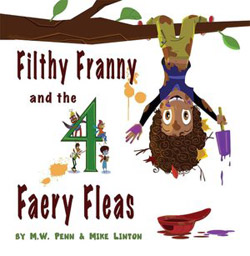A Lesson Plan for Filthy Franny and the 4 Faery Fleas

The theme of Franny and the 4 Faery Flea is the digits of the place value number system in base ten. The goal of this lesson is to have students learn and be able to recite the digits.
NCTM Standards: Pre-K–3 Expectations
The Number and Operations Standard states that in prekindergarten through grade 2 all students should:
• use multiple models to develop initial understandings of place value and the base-ten number system;
• develop understanding of the relative position and magnitude of whole numbers;
• connect number words and numerals to the quantities they represent.
In grade 3 students should:
• understand the place-value structure of the base-ten number system and be able to represent and compare whole numbers and fractions.
Teacher notes:
On page 80 Principles and Standards states: It is absolutely essential that students develop a solid understanding of the base-ten numeration system and place-value concepts by the end of grade 2.
Place value is the value given to the place or position of a digit in a number. In the base 10, we use 10 digits to count increasing powers of ten. For instance, 6345 means 6 times 10 cubed (1000), plus 3 times 10 squared (100), plus 4 times 10 to the first power (10), plus 5 times 10 to the zero power (1). 6000 + 300 + 40 + 5.
The importance of the digit 0 as a place holder is integral to the place value system. 6003 means 6 times 1000 plus 3 times 1. There are no 10s squared or 10s in the number, but the place for these must be indicated. We use 0 to indicate the empty place.
Lesson Plan for grade levels K-2
New words: Digit; place
You will need: A copy of the book and a chalk board or other large board or tablet.
Plan:
Anticipatory Set and Objective: Tell children you will read them a story about very special numbers they use every day, and that, after they’ve heard the story, you will ask them what these numbers are.
Input: Read the story. Ask them to name some of the lands the fleas suggested visiting. Discuss the word digit and lead them to the conclusion that each of the digits is a single (one place) number.
Ask which land Flo thought was the best for Franny to visit? Why? What is in the land of 0?
The digits are the building blocks of our number system. (It’s sometimes helpful to relate the digits to the letters of the alphabet that we use to build words.)To demonstrate the way we use the digits to ‘build’ numbers of base 10, ask the children to help you write a number that doesn’t use these digits. Ask them to give you a number of any length that doesn’t use some of the digits. Stand at the board and write these numbers. They often say a million or a million ‘something’. Write a million (or any number), showing that we use a 1 and six zeros or the necessary digits for that number. Allow children to come to the conclusion that each number they ask you to write is composed of digits 0 through 9.
Modeling: Write the digits on the board or tablet.
Guided practice: Teach children the digit rhyme.
The Digit Rhyme
0, 1, 2, 3, 4, 5, 6, 7, 8, 9
These are all the digit pals standing in a line.
One for every finger tip, one for every toe!
9, 8, 7, 6, 5, 4, 3, 2, 1, 0.
The meter for the poem is:
ze ro one two three four five
six se ven eight nine
these are all the dig it pals
stand ing in a line
one for ev ry fin ger tip
one for ev ry toe
nine eight se ven six five four
three two one ze ro
Checking Understanding: Ask each student write a series of numbers using any 2, 3 and 4 digits. Discuss which digits they used in their numbers. Did anyone write a number that repeated a digit? Ask each child to write a 2 digit number that repeats a digit (11; 22; etc.); a number that uses the digit 0.
Independent practice: Ask the children to find numbers in their home or in the classroom and write these numbers followed by a list of the digits that are used in each number.

Exceptional content and certainly aids with comprehending the topic better.